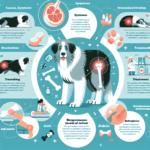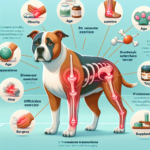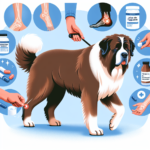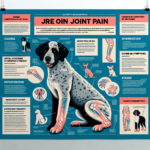Bergamasco Sheepdog Joint Pain: Causes, Symptoms, Prevention, and Treatment

Introduction
The Bergamasco Sheepdog, a breed known for its distinctive matted coat and herding prowess, has a rich history that dates back to ancient times. Originating in the Italian Alps, this breed was primarily used for herding sheep and cattle. The Bergamasco is characterized by its unique coat, which forms naturally into mats or flocks, providing protection against harsh weather conditions. Known for their intelligence, loyalty, and gentle nature, Bergamascos make excellent family pets and working dogs.
Like many breeds, the Bergamasco Sheepdog is prone to certain health issues, with joint pain being a significant concern. Joint health is crucial for this breed, given their active lifestyle and working background. Ensuring the well-being of their joints can help maintain their quality of life and prolong their active years.
Breed-Specific Joint Pain Risks
Genetic Predisposition
The Bergamasco Sheepdog, like many large breeds, is genetically predisposed to joint-related issues such as hip dysplasia, arthritis, and elbow dysplasia. Hip dysplasia, a condition where the hip joint doesn’t fit properly into the hip socket, is particularly common. This genetic predisposition can lead to early onset of joint pain and mobility issues if not managed properly.
Age-Related Risks
As Bergamascos age, the risk of developing joint pain increases. Typically, signs of joint issues may start to appear in middle age, around 5-7 years old. However, some dogs may show symptoms earlier, especially if they have a genetic predisposition. It’s essential to monitor their joint health as they age to catch any issues early.
Activity Level and Joint Stress
Bergamascos are active dogs that thrive on physical activity. Whether herding livestock or engaging in vigorous play, their joints are subjected to significant stress. While regular exercise is beneficial, excessive or high-impact activities can exacerbate joint issues. Owners should balance their dog’s activity level to prevent undue stress on their joints.
Common Symptoms of Joint Pain in Bergamasco Sheepdogs
General Symptoms
- Limping: One of the most noticeable signs of joint pain is limping or favoring one leg over another.
- Stiffness: Dogs may show stiffness, especially after resting or sleeping.
- Reluctance to Move: A dog in pain may be hesitant to engage in activities they once enjoyed, such as running or jumping.
- Difficulty Rising: Struggling to get up from a lying or sitting position can indicate joint pain.
- Swelling: Visible swelling around the joints can be a sign of inflammation.
Breed-Specific Symptoms
In Bergamascos, joint pain may manifest as a reluctance to herd or perform tasks they were trained for. They may also show changes in their gait, such as a bunny-hopping motion when running, which can indicate hip dysplasia.
When to Consult a Vet
If you notice any of the above symptoms, it’s crucial to consult a veterinarian. Early intervention can prevent further deterioration and improve your dog’s quality of life. Regular check-ups are also essential for early detection and management of joint issues.
Preventive Measures for Joint Health
Exercise Recommendations
Regular, low-impact exercise is vital for maintaining joint health in Bergamascos. Activities such as swimming, walking, and controlled play can help keep their joints flexible without causing excessive stress. Avoid high-impact activities like jumping or running on hard surfaces.
Dietary Suggestions
A balanced diet rich in nutrients that support joint health is essential. Look for dog foods that contain glucosamine, chondroitin, and omega-3 fatty acids. These nutrients help maintain cartilage health and reduce inflammation. Supplements can also be beneficial but should be used under veterinary guidance.
Weight Management
Maintaining a healthy weight is crucial for reducing joint stress. Excess weight can exacerbate joint issues and lead to early onset of pain. Monitor your dog’s weight and adjust their diet and exercise routine as needed to keep them at an optimal weight.
Early Screening and Monitoring
Regular veterinary check-ups and early screening for joint issues can help catch problems before they become severe. X-rays and other diagnostic tools can identify early signs of hip dysplasia or arthritis, allowing for timely intervention.
Treatment Options for Joint Pain
Non-Surgical Treatments
Non-surgical treatments for joint pain include medications such as non-steroidal anti-inflammatory drugs (NSAIDs) to reduce pain and inflammation. Physical therapy can also be beneficial, helping to strengthen muscles around the joints and improve mobility. Lifestyle adjustments, such as modifying exercise routines and providing supportive bedding, can also alleviate symptoms.
Surgical Options
In severe cases, surgical intervention may be necessary. Common surgeries for joint issues include hip replacement, arthroscopy, and joint fusion. These procedures can significantly improve quality of life but come with risks and require a recovery period. Consult with a veterinary orthopedic specialist to determine the best course of action.
Alternative Therapies
Alternative treatments such as acupuncture, hydrotherapy, and massage can provide additional relief for joint pain. These therapies can help reduce inflammation, improve circulation, and promote overall well-being. Always consult with your veterinarian before starting any alternative treatments.
Lifestyle and Management Tips
Daily Care Routine
A daily care routine for a Bergamasco with joint pain should include gentle exercise, a balanced diet, and regular monitoring of their condition. Incorporate low-impact activities like short walks and swimming into their routine. Provide a comfortable, supportive bed to help them rest and recover.
Modifying the Home Environment
Making your home more comfortable for a dog with joint pain can significantly improve their quality of life. Consider installing ramps to help them navigate stairs and providing orthopedic beds for better support. Non-slip mats can also prevent falls and reduce joint stress.
Long-Term Management
Long-term management of joint pain involves regular veterinary check-ups, ongoing physical therapy, and maintaining a healthy lifestyle. Monitor your dog’s condition and adjust their care routine as needed to ensure they remain active and happy.
FAQs About Bergamasco Sheepdogs and Joint Pain
What are the early signs of joint pain in Bergamascos?
Early signs include limping, stiffness, reluctance to move, and difficulty rising. If you notice any of these symptoms, consult your veterinarian for a thorough examination.
Can joint pain in Bergamascos be prevented?
While genetic predisposition cannot be entirely prevented, maintaining a healthy weight, providing a balanced diet, and ensuring regular, low-impact exercise can significantly reduce the risk of joint pain.
Are there specific foods that can help with joint health?
Yes, foods rich in glucosamine, chondroitin, and omega-3 fatty acids can support joint health. Consult your veterinarian for dietary recommendations tailored to your dog’s needs.
When should I consider surgery for my dog’s joint pain?
Surgery should be considered when non-surgical treatments are no longer effective, and your dog’s quality of life is significantly impacted. Consult with a veterinary orthopedic specialist to explore surgical options.
Conclusion
Joint pain is a common issue in Bergamasco Sheepdogs, but with proper care and management, it can be effectively controlled. Regular exercise, a balanced diet, and early screening are crucial for maintaining joint health. If your dog shows signs of joint pain, consult your veterinarian for a comprehensive treatment plan. By taking preventive measures and providing appropriate care, you can ensure your Bergamasco enjoys a happy, active life.




